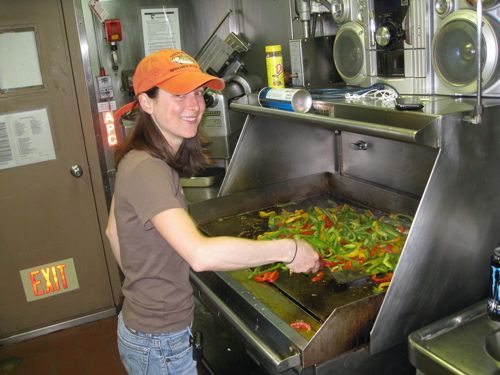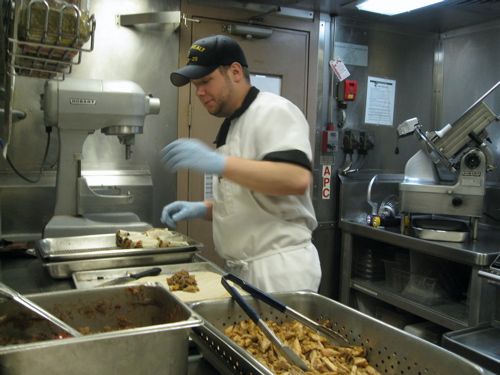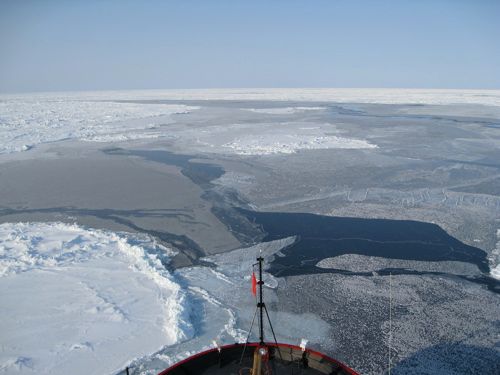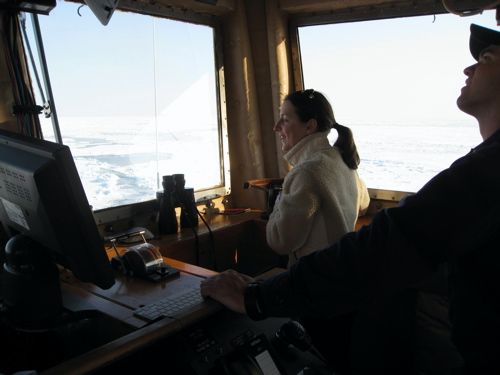Latitude: 62 10.711 N Longitude: 174 16.458So what do 130 people eat for four meals a day in the middle of the Bering Sea? A lot! Curious about what goes on behind the scenes in this miniature restaurant-at-sea, I took a timeout from science this morning and joined the Mess Crew! It turned out to be a whole mess of fun!
The cook staff on the ship is made up of 6 crew members. They take turns, serving, setting up, cooking and baking. With four mealtimes daily, that doesn't give anyone much of a day off. In fact, on their days off they even come in to dish out the food to the hungry diners. Breakfast is served from 7-8, lunch from 11-12 and dinner from 5-6. Then there's "Midrats" from 11-12 for those people who work through the night. I worked the lunch shift as a prep cook/server and the dinner shift as a dishwasher.
One of the first questions that people write to me when they send me emails at sea is "How's the food"? Honestly, it's very good. This is pretty surprising considering the fact that the cooks have to please many different food preferences, allergies and restrictions on a supply of food that has to be kept fresh from port to port. In this case, that is 40 days! Take lunch today for example...
When I arrived in the kitchen at 0830 FS3 Mark Hamilton was already prepping a beef and vegetable soup. He set me up with a knife, cutting board and a pile of veggies. I chopped, diced and julienned peppers, carrots, onions and mushrooms. We added this to some beef that he sautéed on the flattop grill and the soup was ready to simmer. Meanwhile, in one of the four huge industrial "Smart Ovens" four trays of different kinds of sausages were cooking in preparation for a sausage sandwich "Speed Bar".
 Mark moves quickly to get lunch ready for the masses. Opening the oven fills the kitchen hallway with steam and sausage smells.
Mark moves quickly to get lunch ready for the masses. Opening the oven fills the kitchen hallway with steam and sausage smells.
Check out the picture of me below frying up some peppers as toppings...
 Peppers and sausages! I cooked the toppings on the flattop grill.
Peppers and sausages! I cooked the toppings on the flattop grill.
FS2 Doug Dull spent the morning rolling the "Santa Fe" wraps, tortillas stuffed with chicken, black beans and jalapenos. These were served on the hot-line with mixed veggies and onion rings.
 Doug carefully preps four trays of
Doug carefully preps four trays of
I opted for a quick bite from the salad bar before we started serving-mixed greens, nuts, tofu and zucchini with a bag of veggie chips. Ooh la la- tofu on a Coast Guard vessel... who knew?
So, needless to say, these guys work really hard provide everyone with lots of choices at every meal! When I asked Doug what he likes best about working in the kitchen, he told me "It's something new everyday!" With Pesto Pork Loin and Shepherd's Pie on the Menu tomorrow, it certainly is!
After serving lunch and washing a heap of messy dishes at dinner it was time for a new challenge. You know, something like... driving the boat? Why not?
Climbing the stairs to the "Aloft Con" I really just hoped to find the best view in the house.
 This is what I had climbed to the top of the ship for- 11 miles in each direction!
This is what I had climbed to the top of the ship for- 11 miles in each direction!
This 10 x 10 foot area above the Bridge houses a small auxiliary control center from which the boat can be steered when there is heavy ice coverage. Coverage was at a 90% when I arrived at what seemed to be the top of the world. Looking out over the bow, the view stretched for 11 miles in each direction. The view alone was worth climbing the ladder to get there. I certainly didn't know that "Chief" would be turning over the steering wheel to me but that's just what he did. "Tell the Ensign to step aside, it's time to drive!", he said telling me that the officer that he was already training would be turning over the controls to me.
 At the top of the world and at the controls! It doesn't get much better than this. Chief is coaching me on every turn from the sidelines-out of the camera's view.
At the top of the world and at the controls! It doesn't get much better than this. Chief is coaching me on every turn from the sidelines-out of the camera's view.
Chief carefully coached me on how to navigate through the icy waters and which way to turn the wheel to avoid "bouncing" between ice floes. Learning how to steer a 16,600 ton ship through the Arctic is pretty stressful- especially when doing it wrong means getting stuck until the wind moves the ice out of the way- three maybe four days even. (No pressure.) The steering wheel was much like a car but the gas pedal is the "throttle", a lever to the left of the wheel, which controls how much "go-power" the ship uses at a given time. By looking at the ice, Chief was able to decide how much power was just right to break through in just the right way. While it was very exciting to control something so massive, I was happy to turn the wheel back over to him and sleep well knowing that he was steering us in the direction of the next station.
Back in the lab and on the ice again tomorrow! Stay tuned for filtering seawater and the "No-talent" Show...

